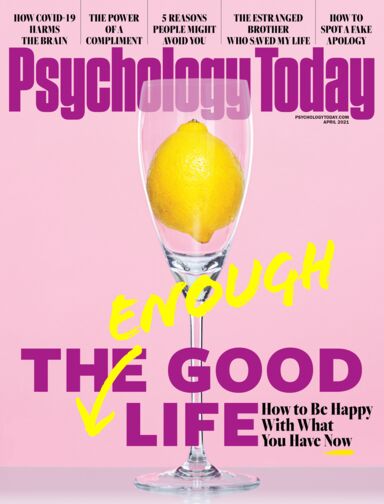What You Need to Know about Spiritual Illness and Disease
How We can Do Better for Ourselves and the World
Posted Mar 20, 2021
My last blog took us back some four billion years to set a foundation for deconstructing illness and disease. My intention was to build on that foundation and talk further about the evolutionary molecular and cellular mechanisms that exist in us today and determine whether we are diseased and ill versus healthy and well. My trajectory was to move from physical to mental to social, and then to spiritual illness and disease. However, given the times we are in I find myself compelled to vault forward to the spiritual.
We are inherently a spiritual species, and yet, we fill the world with so many aspiritual and anti-spiritual constructs and behaviors. Why? The reality is we are both a spiritual and an aspiritual species.
In general humans, like most species, have four fundamental or primary phenotypes (even these can be subdivided), or genetic expressions, that are reflected in our chemical soup, mitochondria, cells, tissues, organs, emotions, thoughts, behaviors and relationships. We look very different in these different phenotypical states. Particularly notable to this discussion is what we look like in threat. In threat we can be mobilized towards aggressive or reactive defenses or we can be immobilized into passive or submissive defenses. Both phenotypes are helpful for survival, but long-term defense states are ultimately destructive to us.
For contrast and clarity, I’ll explain further starting with a place of safety.
When we are safe, we have two phenotypes. One is a mobilization response where we approach, bond, empathize, love, reproduce, seek resources, share resources, problem solve, discover, create, sing, dance, play, laugh, and experience interpersonal connections. This is frequently referred to as ‘breed and feed” physiology although it is clearly much more than just that. The other safety phenotype is one of relative immobilization where we relax, repair, recovery, digest, defecate, contemplate, day-dream, sleep, dream, and experience spiritual connections. This is frequently referred to as “digest and rest” physiology although it too is much more than that.
When we are threatened, we also have two defensive phenotypes. One is a mobilization response to threat where we can prejudge, react, attack, argue, criticize, blame, and experience interpersonal disconnections. This is frequently referred to as “fight and flight” physiology. The other threat phenotype is one of relative immobilization where we retreat, ruminate, isolate, dissociate and experience bodily and spiritual disconnections. This is frequently referred to as “falter (or freeze) and faint” physiology.
Each of these fundamental states is reflected in our molecular make up and mitochondrial, cellular and metabolic functions, and reflected in our intercellular, hormonal, neural, cardiovascular, gastrointestinal, immunologic, endocrinologic, psychologic, sociologic networks, as well as, in our spiritual network.
Our angels live in safety and our devils live in threat – and we all have both. It is therefore imperative that we evaluate and understand threat well. What are our threats? There are many.
Physical threats come in the forms of things like infections - prions, viruses, bacteria, protozoa, and mycelia, or things like toxins – pollutants, pesticides, radiation, medications and substances of addiction. Also, threats come from physical traumas - attacks, assaults, accidents or abuse - lions, tigers, bears – oh my! and even, maybe especially, other people. We have to watch out for motor vehicles, knives and guns. Also, tornados, hurricanes, droughts, fires, global warming and war threaten us physically. Lack of clean soil, water, air and lack of nutritious food are a threat to us. What about over work or lack of sleep? Yep – threat. There are a lot of physical threats that can flip our physiology into a defense state.
Most of our evolutionary strategies to negotiate threat and escape danger come from this physical realm. For four billion years plus defending physical threat was the imperative, so we have some pretty good hardwiring for this kind of threat. However, with the modern human species, homo sapien, only (200,000 years old) and the modern world (5,000 years old at best) physical threats have become less significant relative to spiritual threats. Interestingly, our system responds very similarly to spiritual threats as it does to physical threats. There is not a lot of evolutionary diversity for handling this different kind of threat. (In some sense as our spiritual network evolved it co-opted the physical defense system, which was an efficient strategy, but the lack of specificity can be problematic when it comes to chronic threat precipitating illness and disease.)
Spiritual threats can come in the forms of emotional threat or injury. We can experience emotional attacks, assaults, accidents or abuse that effect our physiology similar to a physical threat or injury. Social threat and injury are other forms of spiritual threat and injury that are particularly toxic to humans. Things like isolation, disenfranchisement, discrimination and injustice not only influence our mental health but our physical health, as well. Financial threat and injury have similar affects to physical threat and injury, too.
We don’t need to look any further than basic evolutionary biology to discover why our black, brown and indigenous sisters and brothers suffer more obesity, insulin resistance, diabetes, hypertension, heart disease, cancer, dementia, mental illness, addictions, etc., and die younger, and yes, suffer more from and die at a higher rate from Covid-19. Although there is bias, prejudice and discrimination within the health care industry the explanation for poorer health and poorer health care outcomes in these populations has more to do with the chronic threats rooted in past and present societal illness and disease that effect on our physical and mental health and well-being, than the biases and prejudices within health care itself.
Within the spiritual realm comes our own thoughts. When we are under threat, we create a bias towards negative, selfish, aggressive and prejudiced thoughts. When being chased by a tiger it is helpful to think “danger”, react quickly, judge without contemplation, defend and protect one’s self. Do something or be eaten. It is not a time for deep thought, nor bonding and sharing, or you’ll be sharing a meal with the tiger and not in a good way. Threat brings about adaptive physiology and behaviors that prevent sociality and spirituality, but serve us well in a defense. Chronic threat brings about maladaptive chronic physiology and behaviors that over time increase our illness and disease burden.
But there is more to our threat load than the physical and spiritual, we have the subawareness shadow part of our physiology that tends towards a defense bias and trigger. In the jungle it is better to be safe than sorry. Deep in our brains we are running predictive codes. We are completely unaware of this brain function. Our brains are constantly search to see if we are safe or threatened and this subaware mechanism fine tunes the system based on the incoming information. Some predictive codes are inborn, instincts, but humans actually have very few instincts. Most predictive codes are based on past experiences. This is a form of subawareness learning. Prejudice comes from the predictive codes in the shadows of the brain. Prejudice is bias without awareness. We accumulate threat and trauma codes throughout a life time that bias the system towards threat and trigger threat physiology easily. Also, this threat bias can be passed generationally though epigenetic alterations that effect the transcription of our DNA. Ancestral threat and trauma can be passed forward for generations.
We also house traumatic memories in the threat centers of our brains that are slightly different than predictive codes as they may bubble up to awareness or into nightmarish dreams. These, too, bias the system towards threat physiology.
Most of us hate to deal with negative thoughts or emotions – it just doesn’t feel good. We will compartmentalize thoughts and stuff emotions away. These are our thought suppressions and emotional repressions that also bias the system towards threat physiology.
Ultimately all threats are existential threats, but just bits and pieces of this more massive threat. The huge burden that humans bare is the ability to contemplate our own annihilation – death. This biases our system towards threat physiology and plays a significant role in our health and wellness. As we are an inherently a spiritual species, we frequently fear a spiritual death as much as a physical death. Failure to recognize the effects of all of our existential worries, big and small, leads to all kinds of mishaps and trouble for our species.
Undoubtedly, the shadow network is reflected in our threat physiology - from our DNA to our predictive codes to our traumatic memories to our suppressions and repressions – and plays a large part in behavior, illness, disease and aging.
The summation of physical threats, spiritual threats, shadow threats and existential threat is our total threat load. A chronically high total threat load will lead to maladaptive physiology and maladaptive behavior, and will lead to illness and disease – both physical and spiritual. We have to be aware of this phenomenon in everything we do and we have to be willing to look directly at this reality to be aware and correct course.
So, what is the cure for physical, mental, emotional, shadow, social and spiritual illness and disease? It is simply to move people away from threat and towards safety. No amount of reason or rationalization with someone under threat, who is physiologically incapable of reason in that moment, will work. That is like asking a blind person to see. Give a blind person sight and they will see. No amount of reason, rationalization, or punishment, will restore their sight. Giving a threatened person safety instead of reason, rationalization, or punishment, is the equivalent of giving a blind person sight. The threatened given safety will see, understand, connect, bond and thrive.
In these times personal threat load is extremely high and is being reflected in systemic dysfunction. In fact, the world’s threat load is extremely high and it, too, is being reflected in systemic dysfunction. We are in a time where we need to proactively decrease threat and increase safety in the world.
I’ll leave you to contemplate how not fully understanding our two threat phenotypes and our two safety phenotypes plays a part in the dysfunction we see in the world today from the toxicity of politics; to nationalism; to racism; to gangs, militias, terrorists and wars; to foreign policy; to drug policy, to criminal justice inequality; to income inequality; to social media; to the business practices of marketing, compensation and profit generation; to for-profit illness versus non-profit health care.
We can do better.
“Health does not always come from medicine.
Most of the time it comes from peace of mind, peace of heart, peace of soul.
It comes from laughter and love.”
@healdocumentary
Stay Safe and Stay Tuned,
DRC


















